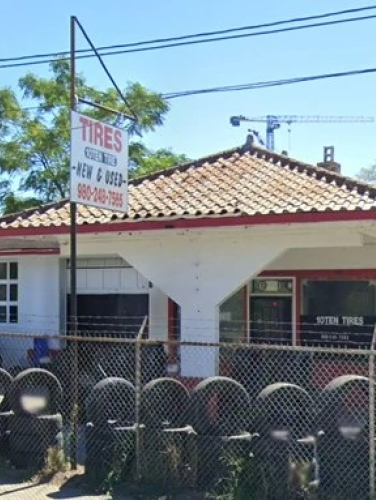
Standard Oil Co. of New Jersey Filling Station
(ca. 1920s)
As the last pre-WWII filling station in uptown Charlotte, the Standard Oil Company of New Jersey Filling Station evidences the growing significance of the automobile during the 20th century.
1010 N. Tryon St., Charlotte, NC 28206
The Standard Oil Company of New Jersey Filling Station is the sole surviving pre-World War II automobile filling station in uptown Charlotte. The pre-1926 construction of this Craftsman-style structure, with its distinctive tiled roof supported by a single column, reflects the early twentieth century rise of the automobile as a major mode of transportation into and out of the burgeoning city’s central corridors.
Property Quick Links
Charlotte’s evolution into a significant regional retail and wholesale mercantile center started with the arrival of the first railroad in October 1852. In anticipation of that event, local businessmen began acquiring parcels of land in and around the intersection of Trade and Tryon Streets for the construction of commercial and mercantile buildings. Over the ensuing decades, wholesale firms and dry goods stores gave way to department stores and specialty retail shops, the emerging textile industries prompted the need for a host of supporting commercial operations ranging from banking to equipment manufacturing, and a growing uptown workforce needed sustenance from restaurants, saloons, and grocery stores. As businesses flocked to uptown, those Charlotteans residing there began to look to streetcar suburbs and other outlying areas for residential options removed from their workplaces, moves facilitated by the introduction of the automobile. By the 1920s, automobiles were becoming increasingly available for purchase by the middle class, and enterprising businessmen sought to take advantage of that expanding market in the very place where their likely customers spent significant time, the uptown commercial district. The Oscar J. Thies Automotive Sales and Service Building at 500 North Tryon Street opened in 1922, with the Roamer (automobile) Sales Agency as its primary tenant. Subsequent occupants of the Thies building included Hipp Chevrolet and Carolina Oldsmobile.
The demands of the automobile increasingly shaped the built environment of uptown Charlotte as the twentieth century progressed. Additional automotive dealerships appeared, including the Thomas Cadillac Company and the Frye Chevrolet Company. The automobile also forced retailers to provide a new amenity, parking. Soon after the end of World War II, Sears Roebuck and Company erected a complex of buildings with a large adjacent parking lot on North Tryon and North College Streets (1949). The Modernist Home Finance Building (1958) at 1102 South Tryon Street was originally designed with an open lower floor to allow for customer parking, with the thought that customers could thereby park within the footprint of the building in lieu of a large extra area paved outside the building.
Filling stations, like the Standard Oil Company of New Jersey Filling Station, quickly followed. When it was first built, the station was surrounded by blocks of small mill houses and duplexes, as well as busy railroad sidings and spurs. But it was not the immediate neighborhood that attracted the filling station. The Standard Oil Station occupied a prominent position along what was then one of the state’s busiest roads. Not only was Tryon Street one of the city’s original defining roads, but it was also part of the first system of paved highways that connected the cities of North Carolina. The Standard Oil Company of New Jersey Filling Station was strategically located to take advantage of the increasing traffic in and out of uptown as Charlotte continued to become a bustling city.

